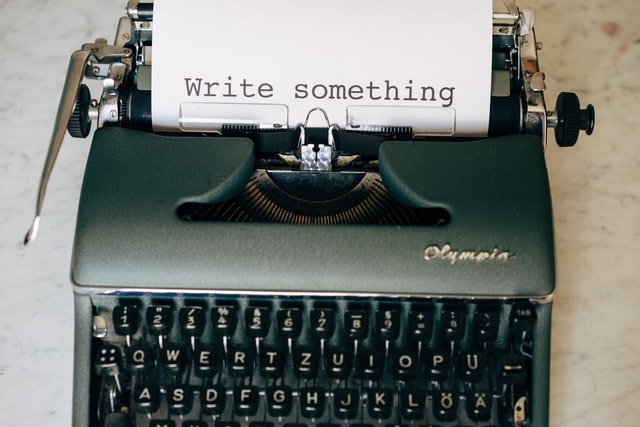3.4 – Drafting
Learning Objectives
- Identify drafting strategies that improve writing.
- Use drafting strategies to prepare the first draft of an essay.
Drafting is the stage of the writing process in which you develop a complete first version of a piece of writing.
Even professional writers admit that an empty page scares them because they feel they need to come up with something fresh and original every time they open a blank document on their computers. Because you have completed the first two steps in the writing process, you have already recovered from empty page syndrome. You have hours of prewriting and planning already done. You know what will go on that blank page: what you wrote in your outline.
Getting Started: Strategies For Drafting
Your objective for this portion of “The Writing Process: How Do I Begin?” is to draft the body paragraphs of a standard five-paragraph essay. A five-paragraph essay contains an introduction, three body paragraphs, and a conclusion. If you are more comfortable starting on paper than on the computer, you can start on paper and then type it before you revise. In this lesson, Mariah does all her work on the computer, but you may use pen and paper or the computer to write a rough draft.
Making the Writing Process Work for You
What makes the writing process so beneficial to writers is that it encourages alternatives to standard practices while motivating you to develop your best ideas. For instance, the following approaches, done alone or in combination with others, may improve your writing and help you move forward in the writing process:
- Begin writing with the part you know the most about. You can start with the third paragraph in your outline if ideas come easily to mind. You can start with the second paragraph or the first paragraph, too. Although paragraphs may vary in length, keep in mind that short paragraphs may contain insufficient support. Readers may also think the writing is abrupt. Long paragraphs may be wordy and may lose your reader’s interest. As a guideline, try to write paragraphs longer than one sentence but shorter than the length of an entire double-spaced page.
- Write one paragraph at a time and then stop. As long as you complete the assignment on time, you may choose how many paragraphs you complete in one sitting. Pace yourself. On the other hand, try not to procrastinate. Writers should always meet their deadlines.
- Take short breaks to refresh your mind. This tip might be most useful if you are writing a multipage report or essay. Still, if you are antsy or cannot concentrate, take a break to let your mind rest. But do not let breaks extend too long. If you spend too much time away from your essay, you may have trouble starting again. You may forget key points or lose momentum. Try setting an alarm to limit your break, and when the time is up, return to your desk to write.
- Be reasonable with your goals. If you decide to take ten-minute breaks, try to stick to that goal. If you told yourself that you need more facts, then commit to finding them. Holding yourself to your own goals will create successful writing assignments.
- Keep your audience and purpose in mind as you write. These aspects of writing are just as important when you are writing a single paragraph for your essay as when you are considering the direction of the entire essay.
Of all of these considerations, keeping your purpose and your audience at the front of your mind is the most important key to writing success. If your purpose is to persuade, for example, you will present your facts and details in the most logical and convincing way you can.
Your purpose will guide your mind as you compose your sentences. Your audience will guide word choice. Are you writing for experts, for a general audience, for other college students, or for people who know very little about your topic? Keep asking yourself what your readers, with their background and experience, need to be told in order to understand your ideas. How can you best express your ideas so they are totally clear and your communication is effective?
Exercise 1
Using the topic for the essay that you outlined in Section 3.2 “Outlining”, describe your purpose and your audience as specifically as you can. Use your own sheet of paper to record your responses. Then keep these responses near you during future stages of the writing process.
My purpose:
My audience:
Setting Goals for Your First Draft
A draft is a complete version of a piece of writing, but it is not the final version. The step in the writing process after drafting, as you may remember, is revising. During revising, you will have the opportunity to make changes to your first draft before you put the finishing touches on it during the editing and proofreading stage. A first draft gives you a working version that you can later improve.
Discovering the Basic Elements of a First Draft
If you have been using the information in this chapter step by step to help you develop an assignment, you already have both a formal topic outline and a formal sentence outline to direct your writing. Knowing what a first draft looks like will help you make the creative leap from the outline to the first draft. A first draft should include the following elements:
- An introduction that piques the audience’s interest, tells what the essay is about, and motivates readers to keep reading.
- A thesis statement that presents the main point, or controlling idea, of the entire piece of writing.
- A topic sentence in each paragraph that states the main idea of the paragraph and implies how that main idea connects to the thesis statement.
- Supporting sentences in each paragraph that develop or explain the topic sentence. These can be specific facts, examples, anecdotes, or other details that elaborate on the topic sentence. Don’t forget to include in-text citations at this step, to help you track your facts and research and avoid forgetting a source as you work.
- A conclusion that reinforces the thesis statement and leaves the audience with a feeling of completion.
These elements follow the standard five-paragraph essay format, which you probably first encountered in high school. This basic format is valid for most essays you will write in college, even much longer ones. For now, however, Mariah focuses on writing the three body paragraphs from her outline. Chapter 4 “Writing Essays: From Start to Finish” covers writing introductions and conclusions, and you will read Mariah’s introduction and conclusion in Chapter 4 “Writing Essays: From Start to Finish”.
Elements of a First Draft
Elements of a First Draft (Text version)
You’ve already seen these terms in context elsewhere in your textbook. Can you identify the correct definition for each of the following words?
- thesis statement
- supporting sentences
- introduction
- conclusion
- topic sentence
- An piques the audience’s interest, tells what the essay is about, and motivates readers to keep reading. (Tip: the first paragraph)
- A presents the main point, or controlling idea, of the entire piece of writing. (Tip: usually the last sentence of the introduction)
- A in each paragraph states the main idea of the paragraph and implies how that main idea connects to the thesis statement. (Tip: usually the first sentence of the paragraph)
- The in each paragraph develop or explain the topic sentence. These can be specific facts, examples, anecdotes, or other details that elaborate on the topic sentence. (Tip: also referred to as supporting details).
- A that reinforces the thesis statement and leaves the audience with a feeling of completion. (Tip: the last paragraph)
Check your Answers: [1]
Activity Source: “Elements of a Draft (Pre-Test 6)” Brenna Clark Gray (H5P Adaptation) is based on content from Writing for Success – 1st Canadian Edition by Tara Harkoff & [author removed], licensed under CC BY-NC-SA 4.0.
The Role of Topic Sentences
Topic sentences make the structure of a text and the writer’s basic arguments easy to locate and comprehend. In college writing, using a topic sentence in each paragraph of the essay is the standard rule. However, the topic sentence does not always have to be the first sentence in your paragraph even if it the first item in your formal outline.
Tip
When you begin to draft your paragraphs, you should follow your outline fairly closely. After all, you spent valuable time developing those ideas. However, as you begin to express your ideas in complete sentences, it might strike you that the topic sentence might work better at the end of the paragraph or in the middle. Try it. Writing a draft, by its nature, is a good time for experimentation.
The topic sentence can be the first, middle, or final sentence in a paragraph. The assignment’s audience and purpose will often determine where a topic sentence belongs. When the purpose of the assignment is to persuade, for example, the topic sentence should be the first sentence in a paragraph. In a persuasive essay, the writer’s point of view should be clearly expressed at the beginning of each paragraph.
Choosing where to position the topic sentence depends not only on your audience and purpose but also on the essay’s arrangement, or order. When you organize information according to order of importance, the topic sentence may be the final sentence in a paragraph. All the supporting sentences build up to the topic sentence. Chronological order may also position the topic sentence as the final sentence because the controlling idea of the paragraph may make the most sense at the end of a sequence.
When you organize information according to spatial order, a topic sentence may appear as the middle sentence in a paragraph. An essay arranged by spatial order often contains paragraphs that begin with descriptions. A reader may first need a visual in his or her mind before understanding the development of the paragraph. When the topic sentence is in the middle, it unites the details that come before it with the ones that come after it.
Developing topic sentences and thinking about their placement in a paragraph will prepare you to write the rest of the paragraph.
Paragraphs
The paragraph is the main structural component of an essay as well as other forms of writing. Each paragraph of an essay adds another related main idea to support the writer’s thesis, or controlling idea. Each related main idea is supported and developed with facts, examples, and other details that explain it, along with in-text citations that point to the sources on the essay’s reference page. By exploring and refining one main idea at a time, writers build a strong case for their thesis.
Paragraph Length
How long should a paragraph be?
One answer to this important question may be “long enough”—long enough for you to address your points and explain your main idea. To grab attention or to present succinct supporting ideas, a paragraph can be fairly short and consist of two to three sentences. A paragraph in a complex essay about some abstract point in philosophy or archaeology can be three-quarters of a page or more in length. As long as the writer maintains close focus on the topic and does not ramble, a long paragraph is acceptable in college-level writing. In general, try to keep the paragraphs longer than one sentence but shorter than one full page of double-spaced text.
Always be guided by what you instructor wants and expects to find in your draft. Many instructors will expect you to develop a mature college-level style as you progress through the semester’s assignments.
Paragraph Length
Paragraph Length (Text version)
How long should a paragraph be?
Long enough! A paragraph can be only a few sentences or much longer, provided it doesn’t ramble. In general, aim for between a minimum of 3 sentences and a maximum of one page of double-spaced text.
Activity source: “Paragraph Length” by Emily Cramer is licensed under CC BY-NC 4.0
Exercise 2
To build your sense of appropriate paragraph length, use the Internet to find examples of the following items. Copy them into a file, identify your sources, and present them to your instructor with your annotations, or notes.
- A news article written in short paragraphs. Take notes on, or annotate, your selection with your observations about the effect of combining paragraphs that develop the same topic idea. Explain how effective those paragraphs would be.
- A long paragraph from a scholarly work that you identify through an academic search engine. Annotate it with your observations about the author’s paragraphing style.
Starting Your First Draft
Now we are finally ready to look over Mariah’s shoulder as she begins to write her essay about digital technology and the confusing choices that consumers face. As she does, you should have in front of you your outline, with its thesis statement and topic sentences, and the notes you wrote earlier in this lesson on your purpose and audience. Reviewing these will put both you and Mariah in the proper mind-set to start.
Mariah’s thesis statement
Here are the notes that Mariah wrote to herself to characterize her purpose and audience.
Purpose & Audience for Mariah’s work
Purpose: My purpose is to inform readers about the wide variety of consumer digital technology available in stores and to explain why the specifications for these products, expressed in numbers that average consumers don’t understand, often cause bad or misinformed buying decisions.
Audience: My audience is my instructor and members of this class. Most of them are not heavy into technology except for the usual laptops, cell phones and MP3 players, which are not topics I’m writing about. I’ll have to be as exact and precise as I can be when I explain possibly unfamiliar product specifications. At the same time, they’re more with it electronically than my grandparents’ VCR flummoxed generation, so I won’t have to explain every last detail.
Mariah chose to begin by writing a quick introduction based on her thesis statement. She knew that she would want to improve her introduction significantly when she revised. Right now, she just wanted to give herself a starting point. You will read her introduction again in Section 3.4 “Revising and Editing” when she revises it.
Tip
Remember Mariah’s other options. She could have started directly with any of the body paragraphs.
You will learn more about writing attention-getting introductions and effective conclusions in Chapter 4 “Writing Essays: From Start to Finish”.
With her thesis statement and her purpose and audience notes in front of her, Mariah then looked at her sentence outline. She chose to use that outline because it includes the topic sentences. The following is the portion of her outline for the first body paragraph. The roman numeral II identifies the topic sentence for the paragraph, capital letters indicate supporting details, and Arabic numerals label subpoints.
Mariah’s Sentence Outline for her 1st body paragraph
- E-book readers are changing the way people read.
- E-book readers make books easy to access and to carry (Baron, 2015).
- Books can be downloaded electronically.
- Devices can store hundreds of books in memory.
- The market expands as a variety of companies enter it (Baron, 2015).
- Booksellers sell their own e-book readers.
- Electronics and computer companies also sell e-book readers.
- Current e-book readers have significant limitations (Baron, 2015).
- The devices are owned by different brands and may not be compatible.
- Few programs have been made to fit the other way people read by borrowing books from libraries.
- E-book readers make books easy to access and to carry (Baron, 2015).
Reference
Baron, N.S. (2015). Words Onscreen : The Fate of Reading in a Digital World. Oxford University Press.
Mariah’s first body paragraph
Exercise 3
Continuing the First Draft
Mariah continued writing her essay, moving to the second and third body paragraphs. She had supporting details but no numbered subpoints in her outline, so she had to consult her prewriting notes for specific information to include.
Tip
If you decide to take a break between finishing your first body paragraph and starting the next one, do not start writing immediately when you return to your work. Put yourself back in context and in the mood by rereading what you have already written. This is what Mariah did. If she had stopped writing in the middle of writing the paragraph, she could have jotted down some quick notes to herself about what she would write next.
Preceding each body paragraph that Mariah wrote is the appropriate section of her sentence outline. Notice how she expanded Roman numeral III from her outline into a first draft of the second body paragraph. As you read, ask yourself how closely she stayed on purpose and how well she paid attention to the needs of her audience.
Mariah’s 2nd body paragraph outline
- Digital cameras have almost totally replaced film cameras (It takes a camera, 2011).
- The first major choice is the type of digital camera.
- Compact digital cameras are light but lack the megapixels.
- Single lens reflex cameras, or SLRs, may be large but can be used for many functions.
- Some cameras that combine the best features of both compacts and SLRs.
- Choosing the camera type involves the confusing “megapixel wars” (It takes a camera, 2011).
- The zoom lens battle also determines the camera you will buy (It takes a camera, 2011)
- The first major choice is the type of digital camera.
Reference
It takes a camera. (2011). Consumer Reports, 76(8), 38-47.
Mariah’s 2nd body paragraph
Digital cameras have almost totally replaced film cameras in amateur photographers’ gadget bags. My father took hundreds of slides when his children were growing up, but he had more and more trouble getting them developed. His smart phone had a camera, but he knew that a stand-alone camera would offer more features, particularly a superior optical zoom (It takes a camera, 2011). He decided to buy a digital camera. But, what kind of camera should he buy? The small compact digital cameras could slip right in his pocket, but if he tried to print a photograph larger than an 8 x 10, the quality would be poor. When he investigated buying a single lens reflex camera, or SLR, he discovered they were as versatile as his old film camera, also an SLR, but they were big and bulky. Then he discovered yet a third type, which combined the smaller size of the compact digital cameras with the zoom lenses available for SLRs. His first thought was to buy one of those, but then he realized he had a lot of decisions to make. How many megapixels should the camera be? Five? Ten? What is the advantage of each? Then came the size of the zoom lens. He know that 3x was too small, but what about 25x? Could he hold a lens that long without causing camera shake? He read hundreds of photography magazines and buying guides, and he still wasn’t sure he was right.
Mariah then began her third and final body paragraph using Roman numeral IV from her outline.
Mariah’s 3rd body paragraph outline
- Nothing is more confusing to me than choosing among televisions.
- In the resolution wars, what are the benefits of higher resolution?
- In the screen-size wars, what does HDR and backlighting mean?
- Does every home really need a media center?
Reference
Hall, P. (2022, March 30). How to choose the right TV. Wired. https://www.wired.com/story/how-to-buy-the-right-tv/
Mariah’s 3rd body paragraph
Exercise 4
Reread body paragraphs two and three of the essay that Mariah is writing. Then answer the questions on your own sheet of paper.
- In body paragraph two, Mariah decided to develop her paragraph as a nonfiction narrative. Do you agree with her decision? Explain. How else could she have chosen to develop the paragraph? Why is that better?
- Compare the writing styles of paragraphs two and three. What evidence do you have that Mariah was getting tired or running out of steam? What advice would you give her? Why?
- Choose one of these two body paragraphs. Write a version of your own that you think better fits Mariah’s audience and purpose.
Writing a Title
A writer’s best choice for a title is one that alludes to the main point of the entire essay. Like the headline in a newspaper or the big, bold title in a magazine, an essay’s title gives the audience a first peek at the content. If readers like the title, they are likely to keep reading.
Following her outline carefully, Mariah crafted each paragraph of her essay. Moving step by step in the writing process, Mariah finished the draft and even included a brief concluding paragraph (you will read her conclusion in Chapter 4 “Writing Essays: From Start to Finish”). She then decided, as the final touch for her writing session, to add an engaging title.
Thesis statement: Everyone wants the newest and the best digital technology, but the choices are many, and the specifications are often confusing.
Working title: Digital Technology: The Newest and the Best at What Price?
Writing Your Own First Draft
Now you may begin your own first draft, if you have not already done so. Follow the suggestions and the guidelines presented in this section.
Key Takeaways
- Make the writing process work for you. Use any and all of the strategies that help you move forward in the writing process.
- Always be aware of your purpose for writing and the needs of your audience. Cater to those needs in every sensible way.
- Remember to include all the key structural parts of an essay: a thesis statement that is part of your introductory paragraph, three or more body paragraphs as described in your outline, and a concluding paragraph. Then add an engaging title to draw in readers.
- Write paragraphs of an appropriate length for your writing assignment. Paragraphs in college-level writing can be a page long, as long as they cover the main topics in your outline.
- Use your topic outline or your sentence outline to guide the development of your paragraphs and the elaboration of your ideas. Each main idea, indicated by a roman numeral in your outline, becomes the topic of a new paragraph. Develop it with the supporting details and the subpoints of those details that you included in your outline.
- Support your ideas with sources, using citations.
- Generally speaking, write your introduction and conclusion last, after you have fleshed out the body paragraphs.
Attribution & References
Except where otherwise noted, this chapter (text & images) is adapted from “8.3 Drafting” In Writing for Success by University of Minnesota licensed under CC BY-NC 4.0. Additional accessibility features have been added to original content.
-
- introduction
- thesis statement
- topic sentence
- supporting sentences
- conclusion. ↵





